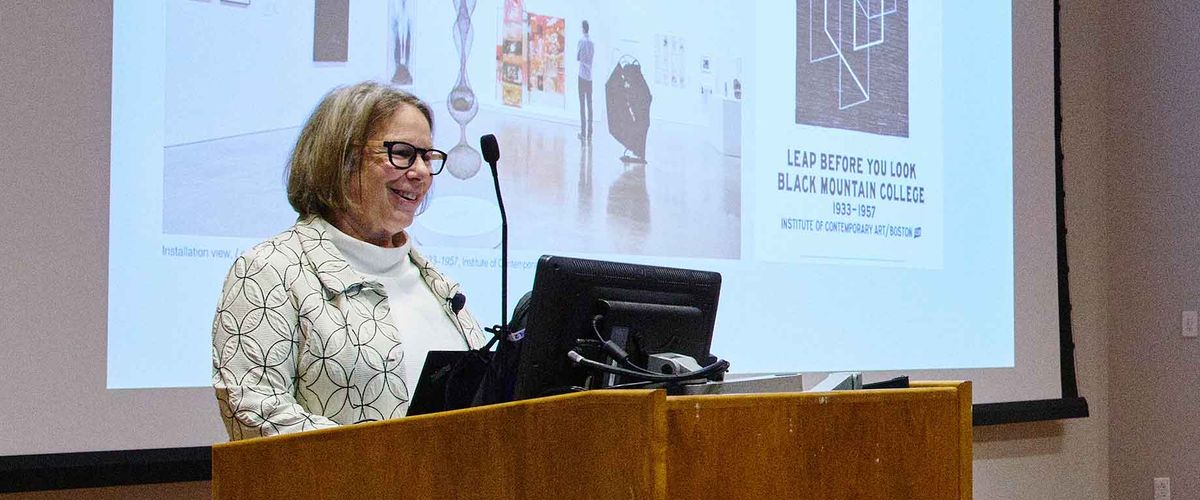In Third Annual Ranalli Lecture, ICA Director Champions Making a Difference by Staying in Place
Many elements of society often trumpet the horn of escape, of journeying onto the next environment, of a life of leaving. For Jill Medvedow, the longtime Ellen Matilda Poss Director of the Institute of Contemporary Art/Boston, however, there is much to be said for staying put, taking root, and, as she put it recently when speaking to the Boston University community, “running in place.”
On Wednesday, May 1, 2024, Medvedow delivered this year’s Daniel Ranalli Lecture. Since 2022, the lecture series has invited prominent US arts leaders to Boston University to share with MET students perspectives, outlooks, and lessons learned over long careers. A nationally renowned advocate for the civic role of art museums, Medvedow has been the ICA’s steward for more than 25 years. Arts Administration Director Douglas DeNatale, in his introductory remarks following MET Dean Tanya Zlateva’s welcome, stated, “Under her leadership, the Institute of Contemporary Art has gone from striving to be marginal to becoming scrappy, then nimble, and finally quite solid.”
In her time as ICA director, the museum has produced numerous influential exhibitions and generated new scholarship and directions in the arts as well as supporting women artists and artists underrepresented in the art-history canon. It’s all been a part of a strategy of having longevity and building works that make a lasting impact.
To the crowd gathered in the BU School of Law Auditorium, Medvedow recounted the stories of mentors and figures who inspired her variety of arts leadership, beginning with that of community organizer and activist Grace Lee Boggs, who she quoted as saying, “How can you understand change when we’re always on the move? The most radical thing I ever did was to stay put.”
The sentiment made a strong impression on Medvedow. In her experience to that point, arts leadership (her preferred term for the field) entailed a chase for the next big thing. A bigger museum, a greater budget, or a larger collection. This variety of aspiration, she said, was alien to her, and sapped her motivation. “It was seen as a solitary endeavor, like genius—male, ambitious, singular,” she said.
But Lee Boggs’ words unlocked a deeper understanding of Medvedow’s own ambitions, which she has up until then mistakenly seen as slight. “A colleague took me to task for this, offering that I had plenty of ambition—[but] it was for my museum, more than for myself,” Medvedow explained. With a new vision and appreciation and a blend of staying in place met with commitment to radical change, she was able to gain clarity into her own ambitions and achievements.
“I’ve been able to craft an alternative model of leadership, one that focuses on impact and relationships as the measure of ambition,” she said.
In addition to impact, time and place also emerged as key tenets to Medvedow’s arts leadership philosophy. Under her guidance, the ICA has gone to lengths to not only build up a community of support for contemporary art, but to also connect with the Boston community and be a model and a conduit for issues of the day as well as a proactive educator and social presence.
One example of this is the many forms of outreach the ICA has offered to local teens. “Teen programs are a way the ICA intentionally serves new audiences and fills gaps in needs in our city,” Medvedow said, citing the influence of the philosopher John Dewey, who championed the cause of experiential learning. The museum’s initiative began more than 20 years ago, when leadership took note of a local news story that reported that youth crime rates were highest in the hours between 2 and 7 pm.
“We asked ourselves, what resources do we as an art museum have to address this situation? So, we began [what] started small and [is] now quite [a] extensive afterschool programs for Boston,” she explained. “Six to seven thousand teens each year come to the ICA for workshops, leadership courses, tours, events designed for and by teens. . . I see it as an investment in our future, our artists, future audiences, future leaders, and [the] future electorate.”
The museum also capitalized on the opportunities of space and place when it opened the ICA Watershed across the harbor in East Boston. This revitalization of a former copper pipe and sheet metal factory brought new energy to a neighborhood and connected it with another one. “We really see it as a redefinition of public art, of a way that public art can actually live and be in conversation in a community,” Medvedow said.
The ICA was able to make good on its commitment to the East Boston community in 2020 when the Watershed was transformed into a food distribution center.
In all, Medvedow centered the importance of the artists whose works populate our museums. “Artists are writing the narratives of our times. They are embodying experience, and at their best they challenge what we already know with what we have yet to imagine,” she said. “And art helps us understand complexity in the world, in ourselves, and in our communities.”
After her remarks, Medvedow was joined by Director DeNatale for a brief conversation. A reception in the auditorium lobby followed.
Dive deeper into the transformative ideas ICA/Boston Director Jill Medvedow outlined during BU MET’s Third Annual Daniel Ranalli Lecture by watching a segment of the discussion in the video below. Don’t miss this unique opportunity for enriching insight and inspiration.
